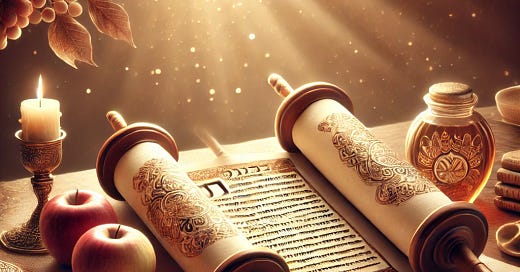Nitzavim-Vayeilech - Stand. Walk. Sit.
Now is the time to prepare for Rosh Hashana by reflecting on all aspects of our lives and envisioning the kind of people we want to become.
Our double-Parsha is especially apt this week, as Parshat Nitzavim is always read on the Shabbat before Rosh Hashana. The section opens with the words "Atem nitzavim hayom", and as I often explain in the name of the Zohar, "hayom" is a code word for Rosh Hashana. The word "hayom" is mentioned no fewer than 16 times throughout our double-parsha.
The first section features Moses’ final discourse on the last day of his life, where the Torah says that everyone from the Jewish people was in attendance. However, the phrase used to express this is intriguing:
מֵחֹטֵב עֵצֶיךָ עַד שֹׁאֵב מֵימֶיךָ
from your woodchoppers to your water carriers (Deuteronomy 29:10).
At first glance, this doesn’t seem to cover a broad spectrum of people. But I once heard a deeper explanation from Rabbi Moshe Heineman shlit”a when I was a student at Ner Yisroel. He explained that the phrase is metaphorical: the "woodcutter" symbolizes those who are fiery and passionate, igniting ideas and sometimes disputes, while the "water carrier" represents those who put out fires, calming tensions and bringing peace.
This idea of the diverse roles among the Jewish people is also reflected in the names of our double parsha. Nitzavim means "standing," which, according to Kabbalistic tradition, is associated with angels. Angels are believed to have only one leg, symbolizing their inability to move or change direction—hence, we stand with our feet together during Kedusha, mimicking their stance. But humans, unlike angels, can move and change, as hinted in Vayeilech—"and he walked" (Deuteronomy 31:1), referring to Moshe. We have the power to walk, to move forward, and to choose our path.
This theme of movement and flexibility is further reflected in the next Shabbat, Shabbat Shuva, which stems from the root "to sit." Together, Nitzavim (standing), Vayeilech (walking), and Shuva (sitting) symbolize the different modes we must adopt throughout life. Each situation calls for a different response—sometimes we need to stand firm, sometimes we need to walk forward, and sometimes we need to sit and reflect. This adaptability is crucial, especially as we approach the High Holidays. Our mission on Rosh Hashana is to ask for the potential to succeed in all these modes of functioning as we prepare for the year ahead.
Many people mistakenly think that Rosh Hashana is just a minor version of Yom Kippur—that we are written on Rosh Hashana but our fates are sealed on Yom Kippur. I like to compare this to a sports game. Some people love sports and watch every minute. Others don’t care, and some are only mildly curious and tune in for the last two minutes just to see the outcome. The same is true for the High Holidays. Some want to experience every moment, some don’t participate, and others only show up for the end—Yom Kippur, or better yet, Neila, the final prayer of Yom Kippur.
And it’s not their fault! The machzor seems to support this idea: "בְּרֹאשׁ הַשָּׁנָה יִכָּתֵבוּן, וּבְיוֹם צוֹם כִּפּוּר יֵחָתֵמוּן"—"On Rosh Hashana it is written, and on Yom Kippur it is sealed." But that’s not the full picture. Rosh Hashana is a completely different holiday from Yom Kippur. It commemorates a different historical event—it deals with humanity as a whole, beginning with Adam and Eve, while Yom Kippur focuses on the Jewish people and forgiveness for the sin of the Golden Calf. There's no mention of sin, no selichot, no viduy on Rosh Hashana. It's a holiday with a distinct purpose.
Rosh Hashana is the holiday of creation, a time to set our ideal potential for the year ahead. It’s a day for deep reflection and envisioning, especially during and after the shofar blasts. Known as Yom Hazikaron—the Day of Remembrance—Rosh Hashana is a holiday of the mind (as Tosefot explains in Rosh Hashana 27a), marking the completion of creation in God's thoughts. What we think about on Rosh Hashana plays a critical role in shaping the potential we are granted for the coming year.
Once Rosh Hashana is over, we lose that unique opportunity. Yom Kippur, Shabbat Shuva, or any other time cannot offer what Rosh Hashana does. It’s our one chance to define our ideal potential through the power of din—God’s strict justice—for the year ahead. Nitzavim-Vayeilech reminds us that today—now—is the time to reflect on all aspects of our lives and the kind of people we want to become—how we stand, walk, and sit. If we do this, the potential for greatness is within our reach.
Shabbat Shalom!
Eliezer Hirsch


